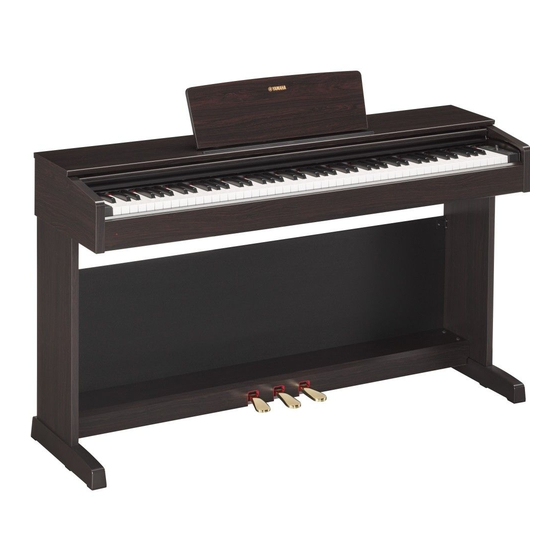
Summarization of Contents
PRECAUTIONS
For AC adaptor
Safety warnings and precautions for the AC adaptor, including usage and handling.
For YDP-163/YDP-143
Essential safety precautions for operating the digital piano, covering electrical shock, fire, and water hazards.
CAUTION
Power and Connection Precautions
Safety advice for power supply, AC adaptor, and connecting components.
Operational and Handling Safety
Guidelines for safe assembly, instrument placement, handling, and bench usage.
NOTICE
Handling and Maintenance
Precautions for handling the instrument, avoiding interference, and safe cleaning procedures.
Data Management and Information
Notes on saving data, copyright, bundled content, and general instrument information.
Tuning Information
Details about the instrument's tuning capabilities and comparison to acoustic pianos.
About the Manuals
Included Manuals
Lists the physical manuals provided with the instrument, like Owner's Manual and Quick Operation Guide.
Online Manuals (PDF)
Details on accessing PDF manuals via the Yamaha Downloads website for advanced topics.
Smart device application
Information about the Digital Piano Controller app for remote instrument control.
Panel Controls and Terminals
Power and Volume Controls
Controls for turning the instrument on/off, standby mode, and overall sound volume.
Performance and Song Controls
Buttons for accessing demo songs, selecting voices, metronome, recording, and playback.
Settings and Connectivity Ports
Features for accessing settings, connecting headphones, computers, and pedals.
Basic Operations
Setting Up
Initial procedures for preparing the instrument, including key cover and music rest.
Basic Operations
Turning the Power On
Steps for connecting the AC adaptor and powering on the instrument.
Setting the Volume
How to adjust the overall sound level using the MASTER VOLUME knob.
Basic Operations
Auto Power Off Function
Information on the automatic power-off feature and how to enable or disable it.
Using Headphones
Guidance on connecting headphones and the stereophonic optimizer feature.
Playing the Piano
Intelligent Acoustic Control (IAC)
Function that adjusts sound quality based on overall volume for clearer low and high notes.
Playing the Piano
Using the Pedals
Explanation of the damper, sostenuto, and soft pedal functions and their effects.
Using the Damper Resonance
How to activate and use the Damper Resonance effect for a grand piano sound.
Playing the Piano
Setting the Operation Confirmation Sounds
How to enable or disable confirmation sounds for setup changes.
Changing the Touch Sensitivity
Adjusting how key presses affect volume and dynamics, with different sensitivity levels.
Playing the Piano
Using the Metronome
Features and operations of the built-in metronome for practicing tempo and rhythm.
Advanced Operations
Playing Various Musical Instrument Sounds (Voices)
Guide to selecting and exploring different instrument sounds available on the piano.
Advanced Operations
Listening to the Demo Songs
Instructions for playing the built-in demo songs to showcase instrument voices.
Advanced Operations
Adding Variations to the Sound (Reverb)
How to select and adjust reverb types and depth for acoustic ambience.
Advanced Operations
Transposing the Pitch in Semitones
Shifting the keyboard pitch up or down in semitones to match other instruments or keys.
Fine-tuning the Pitch
Adjusting the overall pitch in small increments (0.2 Hz steps) for precise tuning.
Advanced Operations
Layering Two Voices (Dual mode)
Combining two instrument voices simultaneously for a richer sound texture.
Advanced Operations
Playing Duo
Function allowing two players to play simultaneously on the left and right sections of the keyboard.
Song Playback and Practice
Listening to 50 Preset Songs
How to select and play the 50 built-in preset piano songs.
Song Playback and Practice
Practicing a One-Hand Part
Isolating and practicing individual hands (left or right) of a song.
Playing from the Beginning of a Measure that Includes Rest or Silence
Feature to control song playback start point, including rests or silence.
Recording Your Performance
Recording Your Performance
Instructions on how to record keyboard performances as User Songs, including tempo and voice selection.
Recording Your Performance
Changing the Initial Settings of the Recorded Song
Modifying parameters like tempo and reverb after a song has been recorded.
Deleting Recorded Data
Procedures for deleting entire recorded songs or specific parts.
Backing up Data and Initializing the Settings
Saving User Song data to a computer
How to transfer User Song data to a computer for backup.
Transferring SMF Files Between a Computer and this Instrument
Procedures for exchanging SMF files with a computer using Musicsoft Downloader.
Initializing the Settings
Resetting all instrument settings to factory defaults, excluding songs.
Appendix
Troubleshooting
Solutions for common problems encountered with the instrument, including power, sound, and pedal issues.
Keyboard Stand Assembly
Attaching Pedal Cord and Stand Components
Steps for connecting the pedal cord and assembling the main stand parts using screws.
Keyboard Stand Assembly
Attaching Piano Unit to Stand
Securing the main keyboard unit to the assembled stand components.
Keyboard Stand Assembly
Connecting Cables and Setting Adjusters
Connecting pedal cord, AC adaptor, setting adjusters, and attaching headphone hanger.
Keyboard Stand Assembly
Moving the Instrument
Precautions and methods for safely moving the assembled instrument or its parts.
Specifications
Product Specifications Overview
Detailed technical specifications including dimensions, weight, controls, voices, and connectivity.
















Need help?
Do you have a question about the YDP-143B and is the answer not in the manual?
Questions and answers